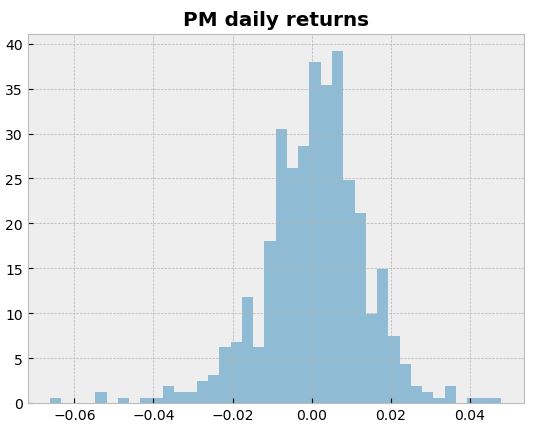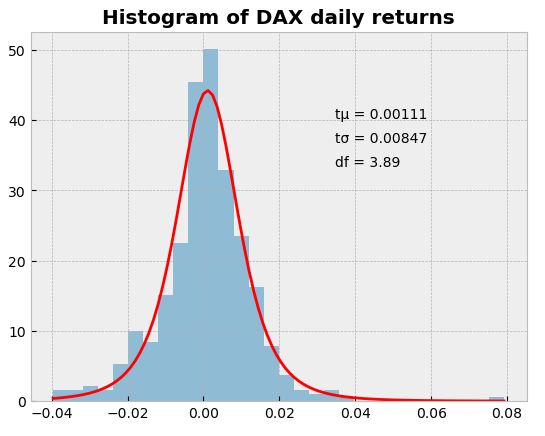Featured Photo by Kammeran Gonzalez-Keola on Pexels
Today we will review and test the Eric Marsden’s e-learning Python courseware and training materials on risk engineering, loss prevention and safety management under the Terms & Conditions of the Creative Commons Attribution-ShareAlike license.
Table of Contents
- Lifetime of Light Bulbs
- Failure of Electronic Components
- Maintenance of a Large Computing Facility
- Failure of Pumps in an Oil Field
- Stock Value at Risk (VaR)
- Stock Correlations
- Summary
- Explore More
Lifetime of Light Bulbs
Input: The lifetime of a light bulb is known to be exponentially distributed with a mean of 5000 hours.
- Q1. Find the proportion of bulbs that may be expected to fail before 4000 hours of use.
- Q2 What is the lifetime that we have 95% confidence will be exceeded?
Solution:
import numpy
import scipy.stats
dist = scipy.stats.expon(scale=5000)
dist.cdf(4000)
0.5506710358827784
The result Q2 is expressed in hours
dist.ppf(0.05)
256.46647193775266
Q1: So about 55% of light bulbs will fail before they reach 4000 hours of operation.
Q2: The 0.05 quantile of the lifetime distribution is 256 hours.
Read More about Survival Analysis.
Failure of Electronic Components
Input: An electronic device will function if both components function correctly. The lifetimes of the 1st and the 2nd components is known to be exponentially distributed with a mean of 3000 and 5000 hours, respectively.
Task: Find the proportion of devices that may be expected to fail before 4000 hours use.
Solution:
The probability of the 1st component still working after 4000 hours is
pa = 1 – scipy.stats.expon(scale=3000).cdf(4000)
pa
0.2635971381157267
and likewise for the 2nd component
pb = 1 – scipy.stats.expon(scale=5000).cdf(4000)
pb
0.44932896411722156
The probability of both working is
pa * pb
0.11844182901380367
So, the proportion of devices that can be expected to fail before 4000 hours’ use is around 88%.
Maintenance of a Large Computing Facility
Input (the maintenance logbook)
15 downtimes over 1 month, 1200 min in emergency maintenance
Tasks:
- The MTTR (mean time to repair) and repair rate
- The probability that the warranty requirement <100 min is being met
- The median time to repair
- The time within which 95% of the maintenance actions can be completed.
Solution:
- MTTR = 1200/15 = 80 min
- The repair rate = 1/MTTR = 1/80 = 0.0125
- PPD of repair time is
dist = scipy.stats.expon(scale=80)
- The probability of time to repair < 100 min is
dist.cdf(100)
0.7134952031398099
- The median time to repair = 0.5 quantile (min)
dist.ppf(0.5)
55.451774444795625
- The time (min) of 95% completed maintenance
dist.ppf(0.95)
239.6585818843192
Failure of Pumps in an Oil Field
Input
From field data in an oil field, the time to failure of a pump, X, is known to be normally distributed. The mean and standard deviation of the time to failure are estimated from historical data as 3200 and 600 hours, respectively.
Task
- What is the probability that a pump X will fail after it has worked for 2000 h?
- If 2 pumps work in parallel, what is probability that the system will fail after it has worked for 2000 h?
Solution
- The probability P(X<2000) = 1 – P(X>2000)
1 – scipy.stats.norm(3200, 600).cdf(2000)
0.9772498680518208
That is the probability of the system working for at least 2000 h is 1 – that of both pumps failing before 2000 hours, which is 1 – 0.977², or 0.9994.
- Given that pump failure is independent, that’s 1 – P(X1<2000) *P(X2<2000)
1 – scipy.stats.norm(3200, 600).cdf(2000)**2
0.9994824314963404
Stock Value at Risk (VaR)
Let’s look at stock market trends and Value at Risk (VaR).
We begin by setting the working directory RISK
import os
os.chdir(‘RISK’)
os. getcwd()
- Importing libraries
import numpy
import pandas
import scipy.stats
import matplotlib.pyplot as plt
from yahoofinancials import YahooFinancials
from datetime import datetime
plt.style.use(“bmh”)
%config InlineBackend.figure_formats=[“png”]
- Introducing the function
def retrieve_stock_data(ticker, start, end):
json = YahooFinancials(ticker).get_historical_price_data(start, end, “daily”)
df = pandas.DataFrame(columns=[“open”,”close”,”adjclose”])
for row in json[ticker][“prices”]:
date = datetime.fromisoformat(row[“formatted_date”])
df.loc[date] = [row[“open”], row[“close”], row[“adjclose”]]
df.index.name = “date”
return df
- Reading the $MO stock data
MSFT = retrieve_stock_data(“MO”, “2021-01-01”, “2023-04-02”)
fig = plt.figure()
fig.set_size_inches(10,3)
MSFT[“adjclose”].plot()
plt.title(“MO Stock”, weight=”bold”);
plt.savefig(‘mostockprice.png’)

- Let’s calculate the MO daily returns

- Let’s plot the histogram of MO daily returns and calculate std
MSFT[“adjclose”].pct_change().hist(bins=50, density=True, histtype=”stepfilled”, alpha=0.5)
plt.title(“Histogram of MO daily returns”, weight=”bold”)
MSFT[“adjclose”].pct_change().std()
0.014316580881876793

- Let’s look at the Q-Q normal distribution plot
Q = MSFT[“adjclose”].pct_change().dropna()
scipy.stats.probplot(Q, dist=scipy.stats.norm, plot=plt.figure().add_subplot(111))
plt.title(“Normal probability plot of MO daily returns”, weight=”bold”);

- Similarly, we can plot the MO Student-t distribution Q-Q plot
tdf, tmean, tsigma = scipy.stats.t.fit(Q)
scipy.stats.probplot(Q, dist=scipy.stats.t, sparams=(tdf, tmean, tsigma), plot=plt.figure().add_subplot(111))
plt.title(“Student probability plot of MO daily returns”, weight=”bold”);

- Let’s look at the rival stock PM in terms of VaR using the historical bootstrap method. We begin with the PM daily returns
stock = retrieve_stock_data(“PM”, “2021-01-01”, “2023-04-02”)
returns = stock[“adjclose”].pct_change().dropna()
mean = returns.mean()
sigma = returns.std()
tdf, tmean, tsigma = scipy.stats.t.fit(returns)
returns.hist(bins=40, density=True, histtype=”stepfilled”, alpha=0.5)
plt.title(“PM daily returns”, weight=”bold”);

returns.quantile(0.05)
-0.021812384359857478
The 0.05 empirical quantile of daily returns is at -0.02. That means that with 95% confidence, our worst daily loss will not exceed 2%. If we have a 1 M€ investment, our one-day 5% VaR is 0.02 * 1 M€ = 20 k€.
- Let’s check VaR using the variance-covariance method
support = numpy.linspace(returns.min(), returns.max(), 100)
returns.hist(bins=40, density=True, histtype=”stepfilled”, alpha=0.5);
plt.plot(support, scipy.stats.t.pdf(support, loc=tmean, scale=tsigma, df=tdf), “r-“)
plt.title(“PM Daily change (%)”, weight=”bold”);

scipy.stats.norm.ppf(0.05, mean, sigma)
-0.021253176229908726
- VaR using the Monte Carlo method
Let’s define the parameters of the geometric Brownian motion
days = 300 # time horizon
dt = 1/float(days)
sigma = 0.04 # volatility
mu = 0.05 # drift (average growth rate)
- Let’s define the random walk function
def random_walk(startprice):
price = numpy.zeros(days)
shock = numpy.zeros(days)
price[0] = startprice
for i in range(1, days):
shock[i] = numpy.random.normal(loc=mu * dt, scale=sigma * numpy.sqrt(dt))
price[i] = max(0, price[i-1] + shock[i] * price[i-1])
return price
- Let’s simulate 30 random walks, starting from an initial stock price of 10€, for a duration of 300 days
plt.figure(figsize=(9,4))
for run in range(30):
plt.plot(random_walk(10.0))
plt.xlabel(“Time”)
plt.ylabel(“Price”);

Final price is spread out between 9.5€ (our portfolio has lost value) to almost 11.25€. We can see graphically that the expectation (mean outcome) is a profit; this is due to the fact that the drift in our random walk (parameter mu) is positive.
- Now let’s run a big Monte Carlo simulation of random walks of this type, to obtain the probability distribution of the final price, and obtain quantile measures for the VaR estimation
runs = 10000
simulations = numpy.zeros(runs)
for run in range(runs):
simulations[run] = random_walk(10.0)[days-1]
q = numpy.percentile(simulations, 1)
plt.hist(simulations, density=True, bins=30, histtype=”stepfilled”, alpha=0.5)
plt.figtext(0.6, 0.8, “Start price: 10€”)
plt.figtext(0.6, 0.7, “Mean final price: {:.3}€”.format(simulations.mean()))
plt.figtext(0.6, 0.6, “VaR(0.99): {:.3}€”.format(10 – q))
plt.figtext(0.15, 0.6, “q(0.99): {:.3}€”.format(q))
plt.axvline(x=q, linewidth=4, color=”r”)
plt.title(“Final price distribution after {} days”.format(days), weight=”bold”);

We have looked at the 1% empirical quantile of the final PM price distribution to estimate VaR, which is 0.431€ for a 10€ investment.
Stock Correlations
Let’s compare the variation of different stock indexes: CAC40 (France), DAX (Germany), the Hang Seng Index in Hong Kong, and the All Ordinaries in Australia:
start = “2021-01-01”
end = “2023-04-02”
CAC = retrieve_stock_data(“^FCHI”, start, end)
DAX = retrieve_stock_data(“^GDAXI”, start, end)
HSI = retrieve_stock_data(“^HSI”, start, end)
AORD = retrieve_stock_data(“^AORD”, start, end)
df = pandas.DataFrame({ “CAC”: CAC[“adjclose”].pct_change(),
“DAX”: DAX[“adjclose”].pct_change(),
“HSI”: HSI[“adjclose”].pct_change(),
“AORD”: AORD[“adjclose”].pct_change() })
dfna = df.dropna()
ax = plt.axes()
ax.set_xlim(-0.15, 0.15)
ax.set_ylim(-0.15, 0.15)
plt.plot(dfna[“CAC”], dfna[“DAX”], “r.”, alpha=0.5)
plt.xlabel(“CAC40 daily return”)
plt.ylabel(“DAX daily return”)
plt.title(“CAC vs DAX daily returns”, weight=”bold”);

scipy.stats.pearsonr(dfna[“CAC”], dfna[“DAX”])
PearsonRResult(statistic=0.9311647843546521, pvalue=2.4314191441635316e-213)
This is a high level of correlation between the French and German indexes.
- Let’s examine AORD vs CAC
ax = plt.axes()
ax.set_xlim(-0.15, 0.15)
ax.set_ylim(-0.15, 0.15)
plt.plot(dfna[“CAC”], dfna[“AORD”], “r.”, alpha=0.5)
plt.xlabel(“CAC40 daily return”)
plt.ylabel(“All Ordinaries daily return”)
plt.title(“CAC vs All Ordinaries index daily returns”, weight=”bold”);

scipy.stats.pearsonr(dfna[“CAC”], dfna[“AORD”])
PearsonRResult(statistic=0.32833306998596323, pvalue=1.2526560187261144e-13)
Here the level of correlation is much lower: daily returns of French and Australian firms are fairly different.
- Let’s check the CAC t-fit
returns = dfna[“CAC”]
returns.hist(bins=30, density=True, histtype=”stepfilled”, alpha=0.5)
support = numpy.linspace(returns.min(), returns.max(), 100)
tdf, tmean, tsigma = scipy.stats.t.fit(returns)
print(“CAC t fit: mean={}, scale={}, df={}”.format(tmean, tsigma, tdf))
plt.plot(support, scipy.stats.t.pdf(support, loc=tmean, scale=tsigma, df=tdf), “r-“)
plt.figtext(0.6, 0.7, “tμ = {:.3}”.format(tmean))
plt.figtext(0.6, 0.65, “tσ = {:.3}”.format(tsigma))
plt.figtext(0.6, 0.6, “df = {:.3}”.format(tdf))
plt.title(“Histogram of CAC40 daily returns”, weight=”bold”);
CAC t fit: mean=0.001179259800176915, scale=0.008089826249985525, df=4.079039153491818

- Similarly, we can check the DAX t-fit
returns = dfna[“DAX”]
returns.hist(bins=30, density=True, histtype=”stepfilled”, alpha=0.5)
support = numpy.linspace(returns.min(), returns.max(), 100)
tdf, tmean, tsigma = scipy.stats.t.fit(returns)
print(“DAX t fit: mean={}, scale={}, df={}”.format(tmean, tsigma, tdf))
plt.plot(support, scipy.stats.t.pdf(support, loc=tmean, scale=tsigma, df=tdf), “r-“)
plt.figtext(0.6, 0.7, “tμ = {:.3}”.format(tmean))
plt.figtext(0.6, 0.65, “tσ = {:.3}”.format(tsigma))
plt.figtext(0.6, 0.6, “df = {:.3}”.format(tdf))
plt.title(“Histogram of DAX daily returns”, weight=”bold”);
DAX t fit: mean=0.0011149895731915964, scale=0.00846914354053661, df=3.889032152342769

Summary
- We discussed top 6 learning examples related to risk engineering, loss prevention and safety management.
- Industrial applications of risk engineering include health and safety in the oil and gas sector, nuclear energy, chemicals manufacturing, aviation, railways, civil engineering and critical infrastructure management.
- We also looked at market risk used in the finance, banking and insurance industries. We estimated VaR using statistical simulations, while analyzing the effect of portfolio diversification and correlation between stocks on financial risk.
Explore More
- Risk Engineering
- Applying a Risk-Aware Portfolio Rebalancing Strategy to ETF, Energy, Pharma, and Aerospace/Defense Stocks in 2023
- Towards Max(ROI/Risk) Trading in Q1 2023
- Stock Portfolio Risk/Return Optimization
- Risk/Return QC via Portfolio Optimization – Current Positions of The Dividend Breeder
- Investment Risk Management Study
Your message has been sent
Make a one-time donation
Make a monthly donation
Make a yearly donation
Choose an amount
Or enter a custom amount
Your contribution is appreciated.
Your contribution is appreciated.
Your contribution is appreciated.
DonateDonate monthlyDonate yearly
Leave a comment